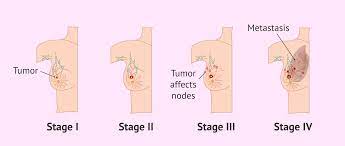Breast cancer is typically staged using a system called the TNM system, which stands for Tumor, Node, and Metastasis. This system assesses the size and extent of the primary tumor (T), the presence and extent of regional lymph node involvement (N), and the presence or absence of distant metastasis (M). The combined information from these factors helps determine the stage of breast cancer. The stages are often designated from 0 to IV, with some subcategories. Here’s a general overview:
Stage 0 (In Situ):
- Stage 0 refers to non-invasive breast cancer, where abnormal cells are found in the lining of a breast duct but have not spread into surrounding breast tissue. The two primary types of stage 0 breast cancer are ductal carcinoma in situ (DCIS) and lobular carcinoma in situ (LCIS).
Stage I:
- Stage I breast cancer indicates that the tumor is small (usually less than 2 centimeters in diameter) and has not spread to nearby lymph nodes or distant sites.
Stage II:
- Stage II breast cancer is divided into two subcategories:
- Stage IIA: The tumor may be small but has spread to nearby lymph nodes, or it’s larger (2-5 centimeters) but hasn’t spread to lymph nodes.
- Stage IIB: The tumor is larger (2-5 centimeters) and has spread to nearby lymph nodes, or it’s larger than 5 centimeters but hasn’t spread to lymph nodes.
Stage III:
- Stage III breast cancer is considered locally advanced and is divided into three subcategories:
- Stage IIIA: The tumor is smaller (less than 5 centimeters) but has spread extensively to nearby lymph nodes, or the tumor is larger (more than 5 centimeters) and may or may not have spread to nearby lymph nodes.
- Stage IIIB: The tumor may be any size and has extended to the chest wall or the skin, causing ulceration or inflammation, but it may or may not have spread to nearby lymph nodes.
- Stage IIIC: The tumor may be any size and has spread extensively to nearby lymph nodes or has spread to lymph nodes near the collarbone or on the opposite side of the breast.
Stage IV (Metastatic):
- Stage IV breast cancer indicates that cancer has spread to distant organs or tissues, often the bones, lungs, liver, or brain. It is considered advanced and is sometimes referred to as metastatic breast cancer.
The stage of breast cancer at the time of diagnosis plays a crucial role in determining the treatment approach and the prognosis. Early-stage breast cancer (Stages 0, I, and II) generally has a better prognosis than advanced-stage breast cancer (Stages III and IV).
However, advancements in treatment options have improved outcomes for many individuals diagnosed with breast cancer at all stages, and survival rates continue to increase with early detection and appropriate treatment. It’s important to consult with a healthcare provider for personalized information and treatment recommendations based on the specific stage and characteristics of the cancer.
For further guidance, consult Dr. Rajinder Kaur Saggu, one of the top Breast Surgeon in Delhi.




